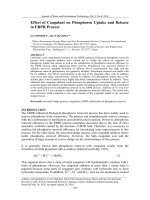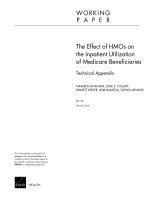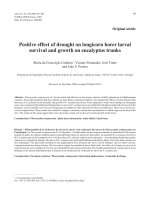Effect of finishing on Knit Fabrics
Bạn đang xem bản rút gọn của tài liệu. Xem và tải ngay bản đầy đủ của tài liệu tại đây (319.15 KB, 34 trang )
School of Science and Engineering, Department of Textile Engineering
Southeast University
Effect of finishing on Knit Fabrics
Effect of finishing on Knit Fabrics 1
School of Science and Engineering, Department of Textile Engineering
Southeast University
Introduction
Textile finishing is a term commonly applied to different
processes that the textile materials undergo after
pretreatments, dyeing or printing for final embellishments to
enhance their attractiveness and sale apparels well as for
comfort and usefulness.
Finishing process improves the physical properties of fabric
like feel, softness, tensile strength, elongation, G.S.M, dia,
shrinkage, spirality, twisting, and insulation properties.
Dhaka,15.05.2011 Effect of finishing on Knit Fabrics 2
School of Science and Engineering, Department of Textile Engineering
Southeast University
The techniques of finishing depend
on the following:
• Nature of the fabric, i.e. chemical composition, state, weave,
etc. This determines the appearance, i.e. transparences,
luster, fullness, weight, whiteness, etc.
• The physical properties of the fabric, i.e. feel, softness,
stiffness, tensile strength, elongation, shrinkage property,
insulation etc.
• The end-use of the material i.e. non-shrinking, non-creasing,
stiffening etc.
• Receptivity of the fabric to various finishing operations, i.e.
water-proofing, flame-proofing, rot-proofing etc.
•
Susceptibility to chemical modifications.
Dhaka,15.05.2011 Effect of finishing on Knit Fabrics 3
School of Science and Engineering, Department of Textile Engineering
Southeast University
Softness
Lusture
Pleasant handle
Drape
Dimensional stability
Crease recovery
Antistatic
Non-slip
Soil release
Finishing treatments are basically
meant to give the textile material
certain desirable properties like:
Dhaka,15.05.2011 Effect of finishing on Knit Fabrics 4
School of Science and Engineering, Department of Textile Engineering
Southeast University
Definition of Finishing
Finishing is a term usually employed for process
other than scouring, bleaching, dyeing or printing,
to which the fabric are subjected to improve their
appearance, properties & serviceability.
Dhaka,15.05.2011 Effect of finishing on Knit Fabrics 5
School of Science and Engineering, Department of Textile Engineering
Southeast University
Classification of Finishes
The most common classifications are:
•
Aesthetic finishes:
•
Functional finishes
Textile finishes are also categorized as:
•
Mechanical finishes (Dry finishes)
•
Chemical finishes (Wet finishes)
Dhaka,15.05.2011 Effect of finishing on Knit Fabrics 6
School of Science and Engineering, Department of Textile Engineering
Southeast University
Classification of Finishes
Finishes can also be classified by their degree of
performance as follows:
•
Permanent finishes
• Durable finishes
• Semi-durable finishes
• Temporary finishes
Dhaka,15.05.2011 Effect of finishing on Knit Fabrics 7
School of Science and Engineering, Department of Textile Engineering
Southeast University
Controling parameter of finishing
Dhaka,15.05.2011 Effect of finishing on Knit Fabrics 8
•
Dia of the fabric
•
GSM of the fabric
• Shrinkage of the fabric
•
Weight loss or gain
•
Tension control
•
Temparature of different stage
•
Spirality control etc.
•
Color fastness of the fabric etc.
School of Science and Engineering, Department of Textile Engineering
Southeast University
Finishing process
Dhaka,15.05.2011 Effect of finishing on Knit Fabrics
.
9
School of Science and Engineering, Department of Textile Engineering
Southeast University
Finishing process
Dhaka,15.05.2011 Effect of finishing on Knit Fabrics 10
School of Science and Engineering, Department of Textile Engineering
Southeast University
Finishing terms
Dhaka,15.05.2011 Effect of finishing on Knit Fabrics 11
GSM:
GSM means fabric weight in grams per square
meter’s .
( )
( )
=
2
Fabric Weight In Grams
length In m
GSM
School of Science and Engineering, Department of Textile Engineering
Southeast University
Shrinkage:
The amount of shrinkage for any given knit fabric is
primarily dependent upon the
product specifications and the knitting parameters used to
meet those specifications.
Formula of shrinkage % measurement:
Dhaka,15.05.2011 12Effect of finishing on Knit Fabrics
.
Finishing terms
−
= ×
Before Wash Length After Wash Length
Length Wise Shrinkage % 100
Before Wash Length
−
= ×
Before Wash Width After Wash Width
Width Wise Shrinkage % 100
Before Wash Width
School of Science and Engineering, Department of Textile Engineering
Southeast University
Finishing terms
Spairality:
“Spirality” arises from twist stress in the
constituent’s yarns of plain fabric, causing all loops
to distort and throwing the fabric wales and
courses into an angular relationship
Dhaka,15.05.2011 Color fastness of dye goods. 13
School of Science and Engineering, Department of Textile Engineering
Southeast University
Finishing terms
Color fastness:
The stability of color or its fastness is one of the
most important requirements of valuable
customers. Colour fastness of dyed goods means
the resistance power of dyed goods against any
hazards.
The color textiles show different resistance power to
different agencies such as light, wash, rubbing,
perspiration, water, bleach, acid, alkali etc.
Dhaka,15.05.2011 Effect of finishing on Knit Fabrics
.
.
14
School of Science and Engineering, Department of Textile Engineering
Southeast University
Effect of Hydro and Dewatering
If water remove from fabric is very much percentage than
fabric surface show crease mark, this fault can’t be
remove.
If length wise run the fabric then 20% shrinkage occurs.
If breakdown occur of de-twister than puckering occurs.
If twist problem occur than it effect on knit garments.
If do not take proper ballooning than folding mark occurs.
Dhaka,15.05.2011 Effect of finishing on Knit Fabrics
.
.
15
School of Science and Engineering, Department of Textile Engineering
Southeast University
Effect of Hydro and Dewatering
If squeeze roller/padder pressure is high than fabric surface
show pressure mark.
If over feed dia of delivery side is not perfect than length
wise shrinkage occurs.
If dia increase than become poor shrinkage properties.
Dia increase in this stage because it helps to better work for
dryer & slitting.
Dia mark also occurs in this stage.
Dhaka,15.05.2011 Effect of finishing on Knit Fabrics
.
16
School of Science and Engineering, Department of Textile Engineering
Southeast University
Effect of slitting
If dia is less than basket dia than fabrics do not cut
and if dia is greater than basket than GSM problem
occurs.
Cut the fabric break wales line wise.
Basket dia must be less then fabric dia.
Dhaka,15.05.2011 Effect of finishing on Knit Fabrics
.
17
School of Science and Engineering, Department of Textile Engineering
Southeast University
Effect of Stentering
Over feed tension is very important for this stage.
If over feed decrease than length increase.
More over feed give in white fabric.
If need light shade of the fabric than increase padder
pressure.
If need dark shade of the fabric than temperature increase
20˚C.
For Lycra heat setting temperature need (190-200) ˚C.
If half feeder Lycra fabric than increase speed and decrease
temp.
If full feeder Lycra fabric temp need 200˚C.
Heat setting takes for width fixed of Lycra fabric.
Dhaka,15.05.2011 Effect of finishing on Knit Fabrics
.
18
School of Science and Engineering, Department of Textile Engineering
Southeast University
Effect of Compacting
Many textile manufacturers have, and still do, rely on
compaction as a means of shrinkage control. Compaction is a
method whereby the course loops are compressed upon
themselves. Different machines incorporate a variety of
techniques to accomplish this. There are basically two
classifications of compaction: heated rolls and shoe units or belt
shrinking units. Both methods rely on speed differential and
their patented compaction zones to accomplish the compaction.
Tubular and open-width systems are available. The fabric is
steamed to add moisture and then introduced to the
compacting zone. The compaction mechanism, along with heat
and moisture, forces the length stitches (courses) to be
compacted.
Dhaka,15.05.2011 Effect of finishing on Knit Fabrics
.
19
School of Science and Engineering, Department of Textile Engineering
Southeast University
Results and discussion
Dhaka,15.05.2011 Effect of finishing on Knit Fabrics
.
20
For finding the effect of finishing on knit fabric
some experiment are done on different types of knit
fabric.
School of Science and Engineering, Department of Textile Engineering
Southeast University
Compare the GSM change for Single jersey
and single jersey lycra fabric
Dhaka,15.05.2011 Effect of finishing on Knit Fabrics
.
.
21
Grey Dyeing Slitting Stentering Compacting
155
160
165
170
175
180
185
190
195
200
GSM
GSM variation Stages
GSM
Grey Heat setting Dyeing Slitting Stentering Compacting
116
118
120
122
124
126
128
130
132
134
136
GSM
School of Science and Engineering, Department of Textile Engineering
Southeast University
Compare the Variation of GSM for 1×1 rib
fabric and Interlock fabric
Dhaka,15.05.2011 Effect of finishing on Knit Fabrics
.
22
Grey Dyeing Slitting Stentering Compacting
180
185
190
195
200
205
210
GSM
Grey Dyeing Slitting Stentering Compacting
170
180
190
200
210
220
230
GSMChange
School of Science and Engineering, Department of Textile Engineering
Southeast University
Compare the variation of GSM for fleece
fabric and Pique
Dhaka,15.05.2011 Effect of finishing on Knit Fabrics
.
23
Grey Dyeing Slitting Stentering Compacting Brushing
200
205
210
215
220
225
230
235
GSM
Grey Dyeing Slitting Stentering Compacting
170
180
190
200
210
220
GSM
School of Science and Engineering, Department of Textile Engineering
Southeast University
Compare the shrinkage % change for Single
jersey and single jersey lycra fabric
Dhaka,15.05.2011 Effect of finishing on Knit Fabrics
.
24
Dyeing Slitting Stentering Compacting
-5
-4
-3
-2
-1
0
1
2
3
Shrinkage%
width%
length%
Dyeing Slitting Stentering Compacting
-5
-4
-3
-2
-1
0
1
Width%
Length%
School of Science and Engineering, Department of Textile Engineering
Southeast University
Compare the Variation Shrinkage % for 1×1
rib fabric and Interlock fabric
Dhaka,15.05.2011 Effect of finishing on Knit Fabrics
.
25
Dyeing Slitting Stentering Compacting
-2.5
-2.0
-1.5
-1.0
-0.5
0.0
0.5
1.0
length%
width%
Dyeing Slitting Stentering Compacting
-3
-2
-1
0
1
Length%
Width%









